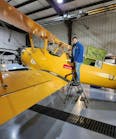Not Science Fiction: Sikorsky Dusts off ‘Flying Wing’ Drone Concept for Pentagon Program
Jul. 8—Sikorsky is seeking federal permission to test a "flying wing" in the skies, as it looks to win a potential Pentagon contract to produce drones that can land on ships and in clearings that lack the runway capacity required by many of the military's larger unmanned aircraft.
The third week of June, Sikorsky was one of nine companies selected to compete under a Pentagon program to produce a new class of drones. Sikorsky is one of two major Pentagon contractors in the mix along with Northrop Grumman. Others include helicopter innovator Piasecki Aircraft, which last year acquired a former Sikorsky facility outside Philadelphia, and drone manufacturer AeroVironment which was on the design team for the Mars Ingenuity helicopter.
Sikorsky's lead executive in Stratford discussed the project in June, evoking the potential impact of the program to the Army's Predator unmanned aerial vehicle, during a forum sponsored by the Connecticut Business & Industry Association. At last report, the U.S. Department of Defense had more than 11,000 unmanned aerial systems in its inventory.
Sikorsky's prototype uses rotors to take off and land vertically, with the spinning blades then blowing air over the wing during forward flight for both propulsion and extra lift. That allows for longer flight durations and slower speeds when needed, an important capability for surveillance missions.
"It actually sits on its tail, launches vertically then flips over and flies like a fixed-wing aircraft," said Paul Lemmo, president of Sikorsky, during the CBIA forum. "It's essentially just a wing — there's no vertical tail or anything."
Straford-based Sikorsky has been looking at the concept for a decade, but it has been busy producing Black Hawk helicopters and developing new helicopters for the U.S. military. Now, with a Bell tilt-rotor aircraft beating out Sikorsky and Boeing to produce a future Black Hawk replacement, Sikorsky is dusting off its "rotor-blown wing" concept for a fresh look.
The company filed for U.S. patents on the concept in 2015 and 2016, and has built a small, battery-operated model of the proposed aircraft. Engineers are now working on a larger, hybird-electric prototype under a contract from the Defense Advanced Research Projects Agency, with Sikorsky seeking permission from the Federal Aviation Administration this week for test flights, according to Aviation Week.
"We're really excited about this — we see this as fulfilling missions [like] carrying cargo or potentially in an intelligence and surveillance and reconnaissance mode," Lemmo said.
In Bloomfield, Kaman is building an unmanned cargo drone for the Marines that can use rotors to take off and land from ships, with the capacity to carry up to 800 pounds of cargo. But thus far, Sikorsky has stuck to manned helicopters, though it has developed autonomous flight technology it is touting for the Black Hawk and other aircraft models, including cargo planes made by other companies.
Sikorsky parent Lockheed Martin produces the Stalker winged drone for the United Kingdom which is capable of vertical takeoff and landings, but with limited capabilities otherwise, including a top speed under 60 miles an hour and a payload below six pounds. Lockheed Martin also makes the unmanned Indago 3 quadcopter mounted with cameras and sensors.
And outside Los Angeles, AeroVironment has had success with its Switchblade drones that can loiter over target areas, with its drones that can be launched from submarines built by General Dynamics Electric Boat in New London. AeroVironment has developed a small, electric helicopter drone called Vapor for surveillance and other purposes.
"The major challenge is developing an integrated flight vehicle that meets the hard objective of combining [vertical takeoff and landing], long endurance, and large payload while also meeting requirements for shipboard storage and operations," said Steve Komadina, a project manager with the Defense Advanced Research Projects Agency, in a press release announcing the next phase of the drone competition.
"A key element is the propulsion system, which needs to have enough power to lift the X-plane vertically while also being extremely efficient in forward flight when power needs are lower," he said.
___
(c)2023 the Connecticut Post (Bridgeport, Conn.)
Visit the Connecticut Post (Bridgeport, Conn.) at www.ctpost.com
Distributed by Tribune Content Agency, LLC.
